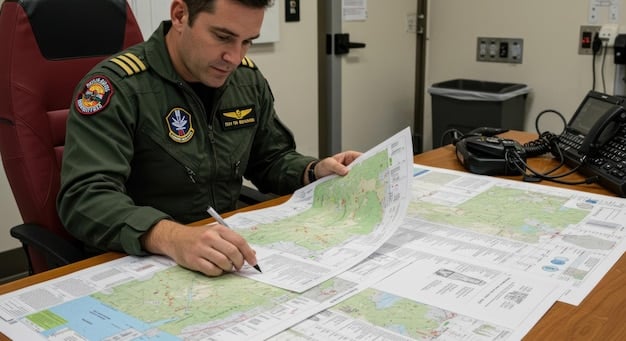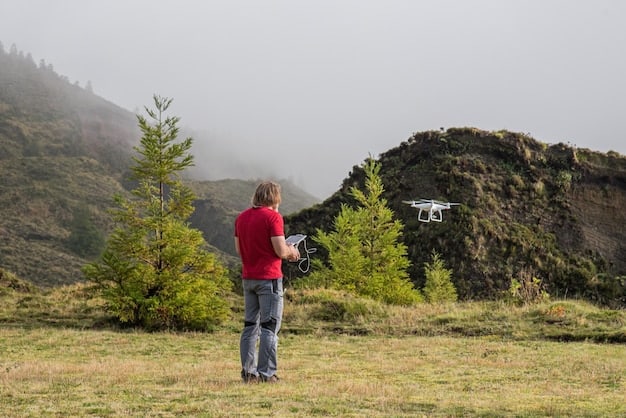FAA Regulations 2025: Impact on Travel Journalist Access

The anticipated FAA regulations in 2025 are poised to significantly reshape travel journalist access by introducing stricter protocols for drone usage, media access to restricted areas, and potentially impacting the speed and scope of news coverage opportunities.
The landscape of travel journalism is on the cusp of significant change. How Will the New FAA Regulations Impact Travel Journalist Access in 2025? These impending changes promise to redefine how journalists gather stories, capture visuals, and report from the skies and beyond.
Understanding the Current FAA Regulations
Before diving into the anticipated impact of the 2025 regulations, it’s crucial to grasp the existing framework. Current FAA rules govern various aspects of aviation, including drone operations, airspace restrictions, and media access during incidents or events. These regulations aim to balance safety, security, and the public’s right to information.
The existing regulations provide a baseline from which to understand the forthcoming changes and how they may potentially shift the landscape for travel journalists.
Key Aspects of Current FAA Regulations
The FAA’s current regulations cover a broad spectrum, but some areas are particularly relevant to travel journalists:
- Drone Usage: Regulations concerning the operation of unmanned aircraft systems (UAS), including registration, pilot certification, and operational restrictions.
- Airspace Restrictions: Guidelines on temporary flight restrictions (TFRs) and restricted airspace zones which impact aerial photography and video.
- Media Access: Policies about media access to accident sites, press conferences, and other aviation-related events.
Each of these aspects plays a key role in shaping how journalists report on travel and aviation-related subjects.

Anticipated Changes in FAA Regulations for 2025
The FAA is expected to introduce new regulations in 2025, with the stated goal of enhancing safety, security, and efficiency within the national airspace system. While the specifics are still under development, potential changes are being discussed that could significantly affect travel journalists.
These changes may encompass new requirements for drone operations, stricter access protocols for restricted areas, and greater scrutiny over media activities at airports and aviation events.
Potential Key Changes
Several potential changes are emerging as possibilities, each with its possibilities and implications for journalists:
- Enhanced Drone Regulations: Stricter rules requiring advanced certifications, operational limitations in urban areas, and mandatory remote identification.
- Restricted Area Access: More stringent protocols for gaining access to areas affected by security incidents or emergencies, potentially limiting real-time reporting.
- Coordination Requirements: New requirements for coordinating media activities with airport authorities and FAA officials, requiring additional lead time and approvals.
These possible changes raise questions about the future of on-the-ground reporting and the ability to deliver timely and accurate information.
How New Regulations Could Impact Drone Journalism
Drone journalism has grown exponentially in recent years, transforming how travel stories are told. However, the new FAA regulations could set new limitations for drones.
With enhanced regulations on drones, journalists will need to adapt their methods, technologies, and creative approaches to continue capturing compelling visual content.
Drone Journalism: Navigating New Hurdles
The challenges of drone journalism post-2025 will depend on how the regulations will impact:
- Urban Operation: Restrictions on flying drones in densely populated areas could limit coverage of urban travel destinations.
- Certification and Remote ID: Higher certification standards and remote identification requirements may pose both financial and logistical challenges for smaller news organizations or freelance journalists.
- Real-Time Reporting: Delays in obtaining necessary approvals could impede timely coverage of important travel-related events.
Journalists need to prepare for upcoming changes to continue to use drones effectively.

Implications for Access to Airports and Aviation Events
Media access to airports and aviation events is vital for reporting on travel industry developments, security procedures, and passenger experiences. Any alterations in FAA regulations in this area could have far-reaching implications.
More stringent background checks, coordination requirements, and restricted zones could impede the ability of journalists to gather firsthand information and report directly from these locations.
Reporting on the Ground: Face New Restrictions
In addition to challenges in covering drone operations, there are new potential restrictions on airport and aviation events:
More bureaucracy may impact the speed of reporting and the scope of coverage.
- Background Checks: Mandatory background checks for media personnel seeking access to secure areas could cause delays and reduce opportunities for spontaneous reporting.
- Coordination Requirements: Stricter coordination requirements with airport authorities and FAA officials may lead to bureaucratic hurdles and limited access.
- Liability and Insurance: Heightened insurance requirements and liability concerns could impact smaller media outlets or independent journalists.
Journalists will need to adjust to meet these increased requirements to share the latest travel news.
Strategies for Travel Journalists to Adapt and Thrive
Despite the challenges, travel journalists can adopt proactive strategies to adapt and continue thriving in the evolving regulatory environment. Education, collaboration, and technological innovation will be essential.
By embracing these strategies, journalists can overcome obstacles and continue telling compelling stories that inform, inspire, and engage audiences.
Staying Ahead of the Curve: Adaptation Strategies
Travel journalists could consider the following ideas to help them report while adhering to the new regulations:
These changes also call for journalists to pursue new certifications and licenses to continue their work.
- Invest in Training and Education: Pursue advanced drone certifications, understand FAA regulations thoroughly, and train in safe operating procedures.
- Build Relationships: Establish strong relationships with airport authorities, FAA officials, and industry stakeholders to facilitate access and cooperation.
- Embrace New Technologies: Explore alternative storytelling techniques, such as 360-degree cameras, virtual reality, and crowd-sourced content, to augment or replace drone footage.
Adopting new strategies and strengthening important relationships will assist journalists in continuing to share the world.
The Future of Travel Journalism Under Evolving Regulations
The evolving FAA regulations underscore the need for travel journalism to become more strategic, innovative, and adaptable. By embracing new tools and techniques, fostering collaboration, and engaging in continuous education, journalists can continue to deliver exceptional reporting.
Though challenges may arise from regulations, these issues can also be opportunities to seek solutions to continue sharing global destinations.
Travel Journalism Moving Forward
Looking ahead, travel journalism must embrace change to survive and thrive.
With strong journalism values, the future will embrace sharing travel news.
- Data Journalism: Incorporate data-driven storytelling to analyze trends, provide insights, and enhance credibility.
- Collaborative Partnerships: Forge partnerships with local communities, tourism boards, and other entities to gain access and insights.
- Advocacy and Education: Advocate for reasonable media access policies and educate the public about the importance of independent reporting.
Travel Journalists can look to the future with hope and excitement, and face the coming changes with an open mind.
| Key Point | Brief Description |
|---|---|
| 🔑 Drone Regulations | Stricter certification & operational limits for drone use. |
| ✈️ Airport Access | More background checks and stricter coordination needed. |
| 🤝 Collaboration | Building relationships key for continued on-site access. |
| 💡 Innovation | Explore new tech like 360° cams & VR for content creation. |
Frequently Asked Questions
▼
The enhanced regulations may require advanced certifications, limit drone operations in urban zones, and require remote identification technology, impacting your ability to capture footage without proper compliance and approvals.
▼
Potential protocols include mandatory background checks for secure area access, stricter coordination with airport authorities, and heightened insurance requirements, which may slow down reporting and limit access.
▼
You can pursue advanced drone certifications, in-depth study of FAA regulations, and training in safe drone operating procedures to improve both knowledge and your technical skills.
▼
Establish ongoing communication, attend industry events, and ensure transparent and ethical conduct to build trust and facilitate access, which are valuable for successful reporting.
▼
Exploring alternative methods like 360-degree cameras, virtual reality, and crowd-sourced content, can enhance reporting even when drone usage is restricted, broadening horizons in travel media.
Conclusion
The incoming FAA regulations in 2025 pose both challenges and opportunities for travel journalists. By staying informed, investing in education, forging partnerships, and embracing technological innovation, journalists can adapt, thrive, and continue delivering compelling stories that captivate audiences worldwide.





